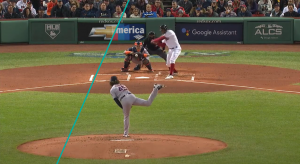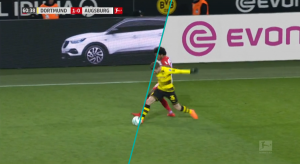SVG Tech Insight: Virtual Advertising - Cutting Through the Regulation
This fall SVG will be presenting a series of White Papers covering the latest advancements and trends in sports-production technology. The full series of SVG’s Tech Insight White Papers can be found in the SVG Fall SportsTech Journal HERE.
This paper proposes a way forward for organizations seeking to implement virtual advertising solutions. Although there is a complex legal framework, with differing positions around the world, we believe it is useful to develop some broad principles in this emerging regulatory area to support the development of the Virtual Advertising sector.
Virtual Advertising has been used in various forms for many years. For example, the digital insertion of on-field logos at sporting events has been experimented with for a couple of decades now.
Only recently, though, has technology advanced to the extent that it is possible to digitally overlay advertising boards that do not impede upon the live action. It is also now possible for multiple broadcast feeds to be distributed to international markets, each displaying different virtual advertisements. As such, a number of rightsholders now exploit virtual advertising to allow tailored advertising to be sold on virtual perimeter boards to different territories or regions. This presents opportunities for advertising to be segmented and, for example, allows:
- Several same-category regional sponsors of an event to secure advertising on the broadcasts, shown in ‘their’ region only;
- A global sponsor to be offered the ability to present different messages in different territories to reflect language, cultural, or taste differences; or
- Virtual perimeter boards offered to the general market to be sold to local brands targeting their local markets only.
The result is the ability to increase advertising revenues.
But, while the tech is ready to go, one of the barriers to wide adoption of these new virtual advertising solutions has been concerns about regulatory issues. This is not a simple regulatory landscape. Much of the relevant regulation is old and does not anticipate this type of technology, and when taking a global approach the thought of taking legal advice in dozens of territories is eye-watering. However, by understanding the issues and the objectives of the regulation, and taking a sensible and risk-based approach to implementation, we believe a way forward can be found.
There are, of course, many national variations, but broadcast regulation in respect of commercial references in editorial programming generally has four key aims wherever you look around the world: avoiding over-commercialization of editorial programming; ensuring broadcaster’s editorial independence and freedom from commercial influence; ensuring viewers are not misled as to what is advertising and what is not; and protecting viewers (or specific audience groups) from inappropriate and subliminal advertising.
These aims tend to manifest themselves in rules on commercial references in programs and ‘product placement’ rules in the following ways:
- Avoiding over-commercialization: controls on ‘undue prominence’ of advertising in programs. (Note that in-program advertising does not normally count towards limits on the quantity of advertising minutes that can be shown in a period, but this should be checked on a territory by territory basis as there are anomalies).
- Editorial Independence: rules to ensure that the advertising is appropriate/natural in the context of the program in question, is not focused/dwelled upon inappropriately, and that producers/broadcasters retain ultimate editorial control;
- Ensuring viewers are not misled: transparency rules, banning ‘surreptitious’ advertising, and requiring notices to be given at the beginning and end of programs to highlight that product placement has been included; and
- Protecting viewers: specific bans on product placement or commercial references in certain types of programming (e.g. news or children’s programs), or in respect of certain types of product (such as alcohol, tobacco/e-cigarettes, ‘unhealthy’ food and drinks, gambling, and medicines). Subliminal advertising is also generally prohibited.
The content of advertising is controlled globally through a combination of legislative mechanisms and ‘self-regulation’ via industry codes of practice, which are adopted and enforced by advertising industry appointed bodies. Above and beyond that, most sports will have rules, whether at an international, regional, national, and/or league/competition level, which governs field of play and kit advertising. Some will deal specifically with virtual advertising. For example, in football in the UK the “Laws of the Game” provide that “No form of commercial advertising, whether real or virtual, is permitted on the field of play, on the ground within the area enclosed by the goal nets or the technical area, or on the ground within 1m (1yd) of the boundary lines from the time the teams enter the field of play until they have left it at half-time and from the time the teams re-enter the field of play until the end of the match.”
Clearly, sports rights owners will need to ensure that any use of virtual advertising complies with such rules. The situation is further complicated by the ongoing pool out of data privacy legislation and the sheer complexities of broadcasting global sport. As regulation is generally country-specific this begs the question, whose laws apply? Is it the country where the relevant sports event is taking place? The country where the sports rights owner or agency (implementing virtual advertising) is based? The country where the relevant digital ads are inserted into the broadcast feed? The country for which a specific advert or virtual feed is targeted?
In fact, this is probably the hardest legal issue to address, particularly given that the answer will vary depending on which of the different types of regulation mentioned above is under consideration, and possibly where the enforcement action is being brought.
This paper therefore proposes an approach which we believe is likely to be compliant in most jurisdictions, such that the question of ‘whose regulations apply’ becomes secondary. Below is a set of low risk principles we would propose the industry could adopt with a view to:
- Minimizing regulatory challenges; and
- Paving the way for low risk exploitation of the opportunities presented by virtual advertising.
Sports rights owners will take a view on the level of risk they are willing to take in each given scenario. This will be influenced by a whole host of factors including PR considerations, likely exposure to contractual liability, the type of advertising, where it will be seen, and relationships with their broadcasters. Getting a view from local broadcasters as to whether they have any concerns about the proposed use of virtual advertising is likely to be very influential.
Principles of Engagement
- Sports-specific rules and regulations which apply to the event being broadcast should always be fully complied with.
- If a broadcast feed is being produced for a specific country, the laws of that country should be complied with.
- Data protection laws should be considered carefully and complied with if you are using personalized advertising in online transmissions.
- For multi-jurisdictional feeds, the following principles are proposed with a view to ensuring compliance with the majority of broadcast and advertising laws and regulations around the world:
- The virtually inserted advertising should be inconspicuous, i.e. it should appear ‘normal’ to viewers who are used to advertising appearing in the context shown in the sporting event.
- The virtually inserted advertising should not be unduly prominent during a program where there is no editorial justification for this.
- Notices should be given at the beginning and end of the program, and between breaks, to state that virtual advertising/product placement is included.
- Advertising for cigarettes, tobacco products, e-cigarettes, prescription only medicines, political advertising, weapons, escort agencies, pornography, and other types of advertising that are banned and/or likely to bring the event into disrepute if advertised should never be inserted into virtual advertising feeds.
- Advertising for other highly regulated products and services such as alcohol, betting, fantasy gaming, ‘unhealthy’ (high fat, salt, sugar) food and drinks, infant formula, and highly regulated financial products such as payday loans should be treated with caution. Different territories will obviously take different approaches.
- This party rights should be respected. A virtual ad should only be placed on to land/buildings or other third-party property: where the land/building owner has consented; where no regulatory consents would be required if the advertising were actually there (or where consent from the relevant regulator has been obtained); and if the virtual advert is replacing physical advertising, where the advertiser has no contractual or other right to object.
- The content of advertisments included in virtual feeds should not be promotional (i.e. not include an active call to action to purchase, or promote sales, offers, or consumer promotions). It should generally only be brand, slogan or product-based advertising.
- A contractual obligation should wherever possible be placed on the advertisers to ensure the adverts they supply otherwise comply with advertising law and regulation in the territories where the ads will be shown.
This is not an exhaustive list, and there are many entities who will accept greater degrees of risk for the appropriate reward. But in the absence of any international regulation it is a useful framework to work with to further establish the success of Virtual Advertising on a global scale.


